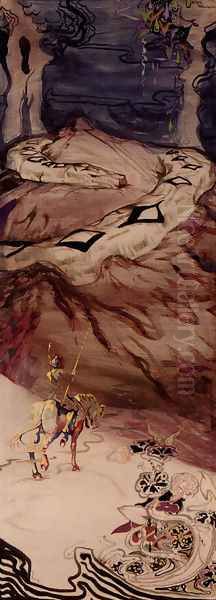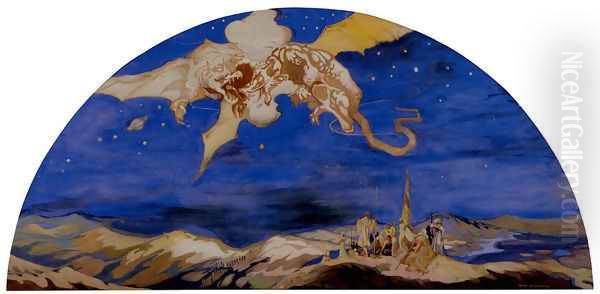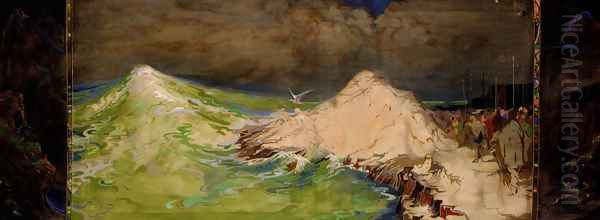George Sheringham (1884-1937) stands as a significant, if sometimes overlooked, figure in early 20th-century British art. His multifaceted career encompassed painting, illustration, interior decoration, and, most notably, theatrical design. Sheringham's work is characterized by its exquisite decorative quality, vibrant use of colour, and a charming synthesis of Eastern and Western artistic traditions, all underpinned by a formidable technical skill. He emerged during a period of rich artistic cross-currents, navigating the tail-end of Art Nouveau, the rise of Art Deco, and the enduring appeal of exoticism in European arts.
Early Life and Artistic Awakening
Born in London in 1884, George Sheringham was the son of a Church of England clergyman, the Reverend Harry Alsager Sheringham. This upbringing, while perhaps traditional, did not stifle his artistic inclinations. His formal art education began at the King's School, Gloucester, a foundation that likely provided a solid classical grounding. Seeking more specialized training, he enrolled at the prestigious Slade School of Fine Art in London.
The Slade, at the turn of the century, was a crucible of talent under influential figures like Henry Tonks, Philip Wilson Steer, and Frederick Brown. Sheringham would have been a contemporary or near-contemporary of artists such as Augustus John, William Orpen, Spencer Gore, and Harold Gilman, who were forging new paths in British painting. While some of his Slade peers were drawn towards a more gritty realism or early modernist experimentation, Sheringham's path would lead him towards the refined and the decorative.
Parisian Sojourn and Developing Style
To further broaden his artistic horizons, Sheringham, like many aspiring artists of his generation, made his way to Paris. He studied at the Sorbonne, immersing himself in the vibrant cultural and intellectual atmosphere of the French capital. Paris was then the undisputed centre of the art world, buzzing with the innovations of Fauvism, the nascent stirrings of Cubism, and the lingering elegance of Art Nouveau. Artists like Henri Matisse, André Derain, and even the earlier influences of decorative masters such as Alphonse Mucha, would have contributed to the rich visual tapestry he experienced.

It was in Paris that Sheringham began to truly hone his distinctive style. He was particularly drawn to the delicacy and compositional freedom he observed in East Asian art, notably Chinese and Japanese screen paintings and prints. This influence would become a hallmark of his work, manifesting in flattened perspectives, asymmetrical compositions, and a lyrical treatment of natural forms, especially flowers and birds. He held his first one-man show in Paris, a significant step for a young artist.
A Flourishing Career in London: Decoration and Design
Upon returning to London, Sheringham quickly established himself as a versatile and sought-after decorative artist. He possessed a remarkable ability to work across various media, from watercolour and tempera paintings to murals, fans, and textile designs. His style, often described as Chinoiserie or Japonisme, was perfectly attuned to the tastes of a clientele that appreciated elegance, fantasy, and a touch of the exotic.
His decorative schemes for interiors were highly regarded. Notable examples include the music room at No. 40 Devonshire Place, London, and decorative work for Hayford Hall. These projects allowed him to create immersive environments, transforming spaces with his delicate motifs and harmonious colour palettes. He often worked with tempera, a medium that allows for precise detail and luminous colour, sometimes incorporating gold paint to enhance the richness of his designs. This meticulous approach set his work apart.
Sheringham was a firm believer in the importance of decoration in art, a field he felt was often unjustly relegated to a minor status in Western art traditions. He argued for the intrinsic artistic value of decorative work, seeing it not merely as embellishment but as a vital form of artistic expression. He famously voiced his opposition to what he termed the "tyranny of the rectangle," advocating for more varied and imaginative compositional formats, such as the semi-circle or the fan shape, which he frequently employed.
Triumph in Theatrical Design
While successful in various decorative arts, it was perhaps in theatrical design that George Sheringham achieved his most widespread acclaim. The early 20th century was a period of revolutionary change in stage design, partly fueled by the sensational impact of Sergei Diaghilev's Ballets Russes, which brought designers like Léon Bakst and Alexandre Benois to international prominence with their opulent and imaginative creations.
Sheringham's own theatrical work was characterized by a similar flair for colour, pattern, and atmosphere. He designed sets and costumes for numerous productions, demonstrating a keen understanding of how visual elements could enhance narrative and mood. His designs were not merely backdrops but integral components of the theatrical experience, often imbued with a sense of fantasy and romance.

A crowning achievement in this field came in 1925 when he was awarded the Grand Prix for theatrical design at the prestigious Paris Salon (Exposition Internationale des Arts Décoratifs et Industriels Modernes). This was a remarkable honour, making him one of the very few British artists to receive such an accolade in this demanding discipline. This award solidified his international reputation and highlighted the originality and skill he brought to stagecraft. One example of his theatre work includes designs for The Sneezing Charm at the Royal Opera House, Covent Garden.
Illustrator of Fantastical Worlds
Sheringham's talents also extended to book illustration, a field in which many of his contemporaries, such as Arthur Rackham, Edmund Dulac, and Kay Nielsen, were achieving great success. His decorative style, with its blend of lyricism and fantasy, was well-suited to illustrating tales of wonder and imagination.
Among his most celebrated illustrative works are the plates for Canadian Wonder Tales (1918) by Cyrus Macmillan. His illustrations, such as "Glooskap Gathers His People," perfectly capture the mythical and folkloric quality of the stories. He brought a delicate sensibility to these images, using flowing lines and subtle colour harmonies to evoke a sense of enchantment. His work in illustration, like his fan paintings and decorative panels, often featured elegant figures, stylized flora, and a dreamlike atmosphere.
Other known works that showcase his painterly and illustrative skills include titles like "The Serpent of the Mount," "A Dragon Passing Over," and "The Tale of Kynon." These pieces, often executed in watercolour and gouache, further demonstrate his mastery of intricate detail and his ability to conjure imaginative scenes.
Artistic Philosophy and Signature Style
George Sheringham's artistic philosophy was rooted in a deep appreciation for beauty, craftsmanship, and the expressive power of decoration. He was not an avant-garde radical in the mould of the Cubists or Futurists, but rather an artist who sought to refine and reinvigorate established traditions, particularly those with a decorative emphasis.
His signature style is recognizable for several key characteristics:
1. East Asian Influence: A profound and sophisticated integration of Chinese and Japanese aesthetics, evident in his compositions, motifs (birds, flowers, willowy trees), and use of space. This was more than superficial Chinoiserie; it was a deeply assimilated understanding of Eastern artistic principles.
2. Colour and Line: A masterful use of colour, often delicate and harmonious, but capable of vibrancy when required. His line work was fluid, elegant, and precise.
3. Medium Mastery: Proficiency in tempera, watercolour, and gouache, often embellished with gold or silver paint, lending a precious, jewel-like quality to his smaller works.

4. Rejection of Convention: His aforementioned dislike of the "tyranny of the rectangle" led him to explore fan shapes, roundels, and other unconventional formats, particularly in his decorative panels and paintings.
5. Versatility: An ability to apply his distinctive style across a wide range of applications, from intimate fan paintings to large-scale murals and theatrical sets.
He was part of a broader movement in British art that valued craftsmanship and design, alongside artists like Charles Ricketts and Charles Shannon, who also worked in theatre and book design, or Claud Lovat Fraser, whose theatrical designs shared a certain whimsical charm. While perhaps not as overtly modernist as some of his contemporaries like Paul Nash or Vanessa Bell (who also engaged with decorative arts through the Omega Workshops), Sheringham carved a unique niche for himself.
The Sheringham Legacy: The Book of the Fly Rod
An interesting, though somewhat poignant, aspect of Sheringham's later life involves his collaboration with his elder brother, Hugh Tempest Sheringham (1876-1930). Hugh was a well-known angling writer, serving as the angling editor for The Field magazine for many years. Together, they planned The Book of the Fly Rod, with Hugh co-authoring the text (along with John C. Moore) and George providing the illustrations.
Tragically, Hugh Sheringham passed away in August 1930, before the book could be fully realized in its intended collaborative spirit. However, the book was indeed published in 1931 by Eyre & Spottiswoode, featuring George Sheringham's charming and evocative illustrations, which beautifully complemented the angling theme. George himself would pass away a few years later, in 1937. This project remains a testament to the brothers' shared passions and talents, blending literature and art.
A Note on Sheringham (the Town) in Wartime
It is worth noting, as a point of local historical interest rather than a direct biographical detail of the artist, that the town of Sheringham in Norfolk played its own small role during World War II. The Sheringham Little Theatre, a community hub, reportedly served as a clandestine meeting place for the local resistance. This detail, while not connected to George Sheringham the artist (who had died before the war), adds a layer of intrigue to the name "Sheringham" in a different context, highlighting how places and names can carry diverse histories. Similarly, the nearby Sheringham Shoal was the site of a secret radar station.
Recognition and Collections
George Sheringham's contributions to art and design did not go unrecognized during his lifetime. Beyond the prestigious Grand Prix in Paris, he was honoured by being one of the first recipients of the distinction of Royal Designer for Industry (RDI) in 1936, an award conferred by the Royal Society of Arts to acknowledge designers of the highest eminence. This award underscored his standing as a leader in British design.
His works were exhibited widely, not only in London and Paris but also in Venice, Brussels, and Berlin, indicating his international reach. Today, George Sheringham's art is held in the collections of major public institutions, including the British Museum, the Victoria and Albert Museum (which has a significant collection of his fan designs and theatrical drawings), and the Tate Gallery. These holdings ensure that his delicate and imaginative art continues to be accessible for study and appreciation.
Later Life and Enduring Influence
George Sheringham remained active as an artist and designer until his death in London on November 11, 1937, at the relatively young age of 53. Despite his prolific output and the recognition he received, his name perhaps faded somewhat from mainstream art historical narratives in the post-war era, which tended to prioritize more overtly modernist movements.
However, in recent decades, there has been a renewed appreciation for artists like Sheringham who excelled in the decorative arts and illustration. His work is admired for its technical finesse, its imaginative charm, and its successful fusion of diverse cultural influences. He left a legacy of beauty and elegance, demonstrating that decorative art could be both sophisticated and deeply expressive.
His influence can be seen in the continuing tradition of decorative illustration and design that values craftsmanship and a lyrical sensibility. He stands as an important link between the aestheticism of the late 19th century and the burgeoning Art Deco style, bringing a uniquely personal vision to the artistic landscape of his time. Artists who followed in similar veins, perhaps in illustration or theatre, would have found in his work a model of refinement and imaginative flair.
Conclusion: An Artist of Refined Imagination
George Sheringham was an artist of remarkable versatility and refined sensibility. From the intimate scale of a painted fan to the immersive world of a theatrical set, he brought a consistent elegance and a distinctive decorative flair to his creations. His ability to synthesize Eastern artistic principles with Western traditions, his mastery of colour and line, and his advocacy for the artistic merit of decoration mark him as a significant contributor to British art and design in the early 20th century. While the currents of modernism often took more radical forms, Sheringham's dedication to beauty, craftsmanship, and imaginative fantasy carved out a unique and enduring legacy that continues to enchant and inspire. His work serves as a reminder of the rich diversity of artistic expression that flourished during a period of profound cultural transformation.